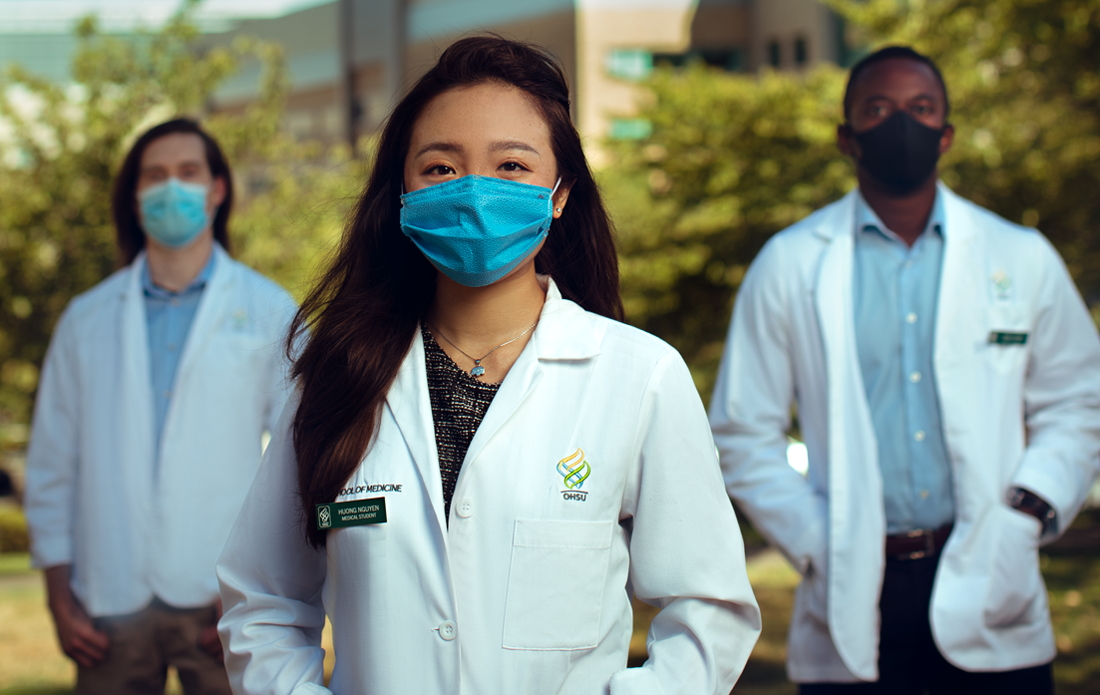Jennifer Ku realized life had truly changed in mid-March. That’s when she logged in for the first time to what had been an in-person class only days before and saw the faces of her classmates popping up in a grid on her computer monitor.
“I saw the WebEx screen and thought, ‘Wow, so this is what it’s going to be like now,’” said Ku, an epidemiology PhD student in her fourth year at the OHSU-PSU School of Public Health. “So much of learning comes from active discussion with classmates in class settings. But instead of raising my hand, I’d type in the ‘chat’ box.”
“Now I’ve gotten used to it,” she added.
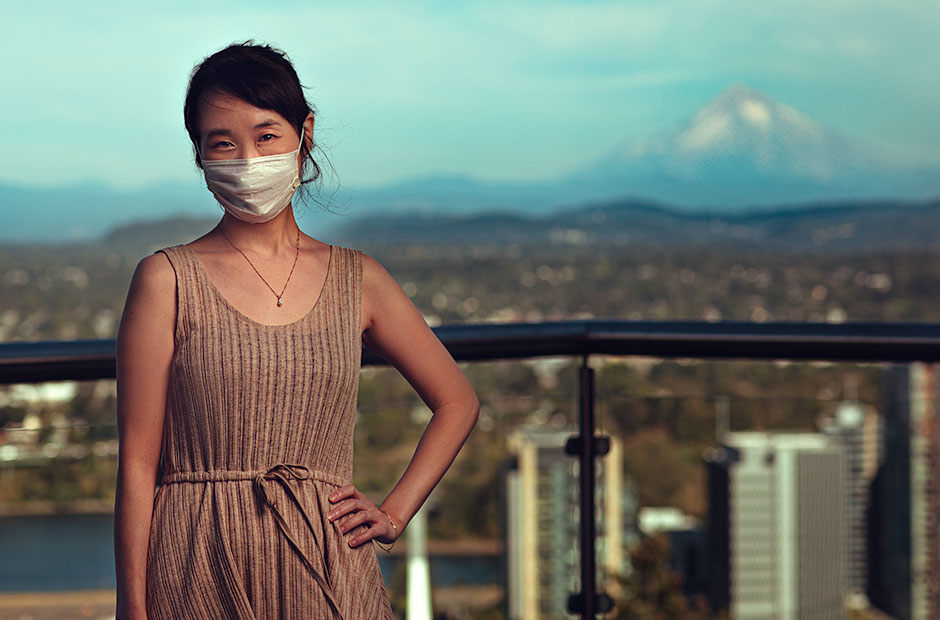
How we got here
COVID-19 didn’t shut down OHSU’s educational mission, but changes necessitated by the pandemic happened quickly. In March 2020, OHSU pulled all clinical students from their rotations and field experiences. Most PhD students shut down onsite laboratory work. Classes transitioned to remote learning. Oregon Gov. Kate Brown halted elective surgeries in an effort to ensure hospitals remained available in case of a surge of COVID-19 patients.
Most of OHSU’s class of 2020 in all schools (OHSU Schools of Medicine, Nursing, Dentistry and the OHSU-PSU School of Public Health) were able to finish their degrees by the scheduled June graduation; in fact, at the School of Medicine, more than 90 of 165 students completed requirements in March as part of OHSU’s early graduation program. Some became interns to immediately help with COVID-19-related patient care issues.
For students in other programs, things got a little more complicated. As training opportunities shifted, programs filled in the gaps with simulations and additional skills labs.
“Obviously this isn’t a long-term solution, but our programs already far exceeded what the Oregon State Board of Nursing requires,” said Carla Hagen, PhD, interim senior associate dean for academic affairs, OHSU School of Nursing.
“Change is inherent in nursing and every corner of health care; there is constant adjustment to new information. It can be frustrating and scary, but I am hopeful for the future.”
Crystal Richard, third-year nursing student
When Gov. Brown allowed elective care to resume on May 15, 2020, patient volume and educational opportunities gradually increased, though not to pre-coronavirus levels. Starting with summer term in June, OHSU carefully restarted field experiences and clinical rotations with some modifications, such as reducing four-week medical rotations to three weeks. By July 2020, nearly all PhD students returned to campus labs.
“Change is inherent in nursing and every corner of health care; there is constant adjustment to new information,” said Crystal Richard, third-year School of Nursing student. “It can be frustrating and scary, but I am grateful for the opportunity to continue my nursing school journey and am hopeful for the future.”
All these actions serve to keep students, staff, faculty and patients safe during a time of extreme uncertainty. But one reason for these actions stemmed from a basic law of supply and demand: an impending shortage of personal protective equipment (PPE) items such as N95 masks, face shields and isolation gowns.
The ongoing role of PPE
PPE availability remains scarce, worldwide. Eighty percent of PPE is produced in China’s Wuhan district, one of the first areas affected by COVID-19. This, along with global exponential growth in coronavirus cases, creates a major disruption in the global supply chain, making crucial lifesaving supplies difficult to obtain.
As part of planning for summer and fall terms, each educational program at OHSU develops a detailed plan outlining how much and what kind of PPE will be required. Dental students are especially in need of PPE, because almost every procedure they do is considered “aerosol-generating”: suspending liquid or solid particles in the air, potentially spreading COVID-19.

PPE shortages will likely continue well into next year, agree educators. It’s one of the primary factors that will influence how education is delivered. At times throughout the year, PPE may need to be restricted and education adjusted accordingly.
“We have a dashboard outlining the availability and allocation of PPE,” said George Mejicano, MD, senior associate dean for education, OHSU School of Medicine. “I look at it every single morning,” he added.
What support looks like
Some online learning was well-established long before COVID-19. Many lectures in the School of Medicine are accessible online for students to review as much as they’d like. At OHSU’s School of Nursing, students regularly performed online and in-person simulations to help develop clinical reasoning skills.
But regardless of whether online instruction was already being incorporated, it became mandatory starting in mid-March. Within days, faculty had to move everything online.
“It was a steep climb, and faculty showed up. They did it amazingly well,” said Susan Bakewell-Sachs, PhD, dean, OHSU School of Nursing.
“Our spring goal was to get courses delivered. Now faculty can further their skills in the online space,” she added. For example, a course in health promotion at the School of Nursing drew upon the experience of virtual simulation experts and experienced online learning “super-users” to create virtual simulations and engaging course content. In addition to supporting faculty, OHSU has been working to support students since the pandemic turned campus life upside down. Students throughout OHSU receive weekly newsletters and frequent email updates. OHSU hosts online forums where students can meet with executive leadership and deans, and is quick to connect students with services such as academic learning support, mental health support and COVID-19 resources.
“I’ve always felt supported by OHSU, especially as a diverse student, but their support became multi-fold during the pandemic.”
Huong Nguyen, third-year medical student
Huong Nguyen, a third-year School of Medicine student says, “I’ve always felt supported by OHSU, especially as a diverse student, but their support became multi-fold during the pandemic. They quickly managed hundreds of schedules and made online resources available so students could maintain full-time enrollment and be productive toward our careers.”
To ensure all students were able to utilize remote learning as effectively as possible, OHSU created a website to provide concise, practical resources, and strategies for students that needed to quickly transition to a fully remote instructional format. Also, many classes instituted a “pass/no pass” option for students stressed about grades. Food insecurity — not having consistent access to enough nutritious food — remains an issue for students, and OHSU is working with the OHSU Foundation to launch a food pantry on Marquam Hill.
The pandemic has raised awareness about health disparities in our culture during a summer when social justice took center stage. Many OHSU students feel passionately about these issues.
OHSU students need your support now more than ever. Learn how you can invest in tomorrow’s health leaders.
“Health disparities and the protests in Portland and around the world have had a huge impact on students,” said Rick Johnson, PhD, professor and associate dean for academic affairs at the OHSU-PSU School of Public Health. “Students have complicated lives these days. These stresses make it hard for them to focus on the business of being a student.”
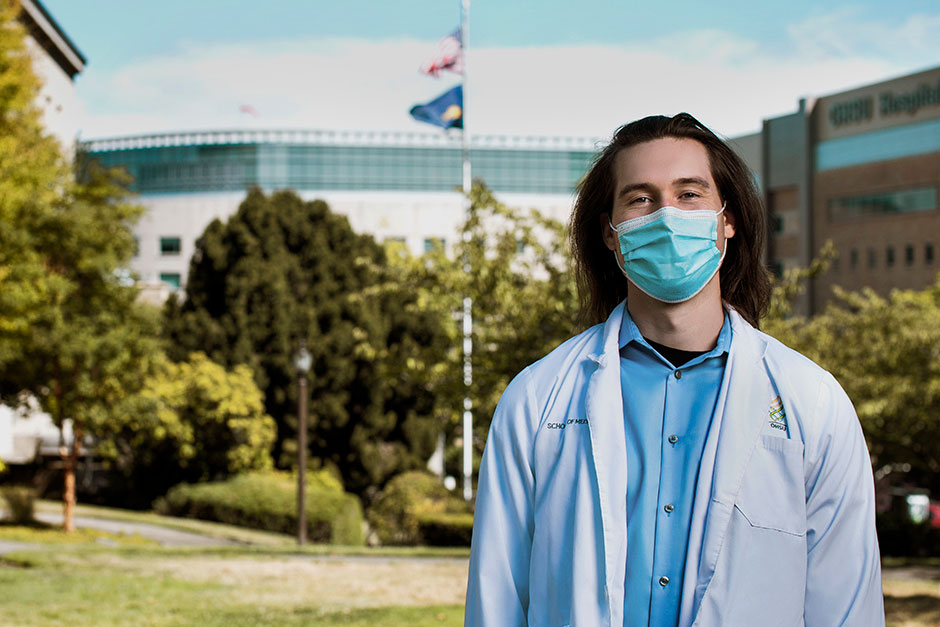
Dana Button, a third-year medical student, has been impressed with OHSU’s announcement about no longer using prison labor for hospital laundry needs. “It’s going to take a lot of discussion and deep work that can make this a sustainable change, but this is an important step forward,” he said.
Second-year medical student Daniel Tshala tries to balance feeling inundated with school and the current environment with support from his fellow students and mentors. “My mentor is a Black physician. Every Monday we meet for about an hour, along with several other Black students and residents. Just having that community and talking to people going through similar emotions has been a helpful support system,” he said. “I know OHSU is making an effort, though it’s going to have to be a cultural change, which will take time. But starting somewhere is better than not starting at all.”
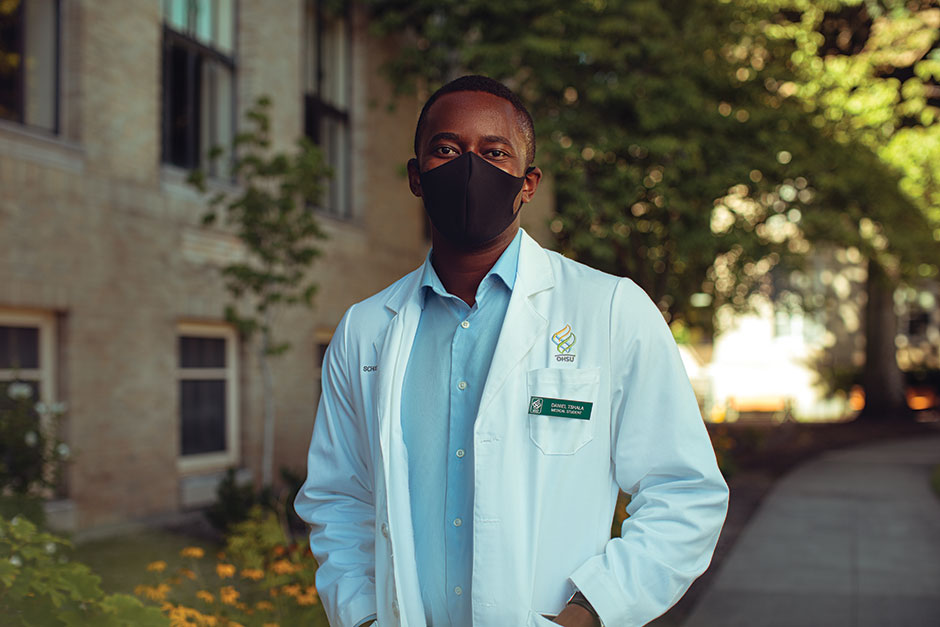
Remote control
The same tools that support students in distance learning are also used to help patients access care. Telehealth at OHSU has skyrocketed since the pandemic began, from about 2,400 telemedicine visits in January 2020 to more than 40,000 in June. It’s providing a new way for students to approach clinical work while social distancing policies remain in place.
“The student, resident physician and attending physician are all able to use video to speak with the patient, and then use our cell phones to consult with each other,” third-year medical student Teva Brender explained. “We still see people with challenging health issues in clinic, but in dermatology, we have been able to do a lot of good work and follow-up with telehealth.”
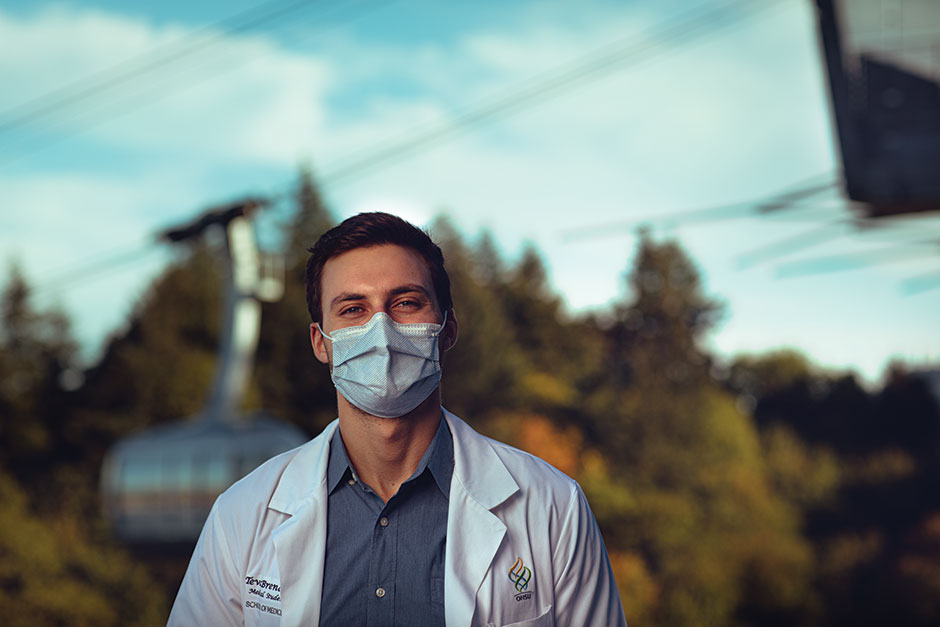
Teledentistry also plays a major role at the School of Dentistry. As part of dental health patient exams, students will spend 20-30 minutes taking a thorough health history and discussing oral health and hygiene with the patient. Now, that’s done via video, freeing up time for dentists to see more patients in person.
COVID-19 has also changed field experiences at the OHSU-PSU School of Public Health. Commonly, public health students work with community partners such as the Oregon Health Authority or county public health groups. But projects are staying closer to home these days.
“A typical project might be evaluating the health of bus drivers as part of a total worker health program. That involves hands-on work like monitoring conditions inside buses. Instead, we can shift to projects like processing data for various health agencies,” said Johnson.
Person-to-person
Sometimes, students simply need to be onsite.
At the School of Nursing, graduate students returned over summer term to work in both acute and community-based settings. Medical students’ clinical rotations now take place in smaller groups and for shorter periods. Dentistry has adjusted clinic hours and patient flow, and by having third- and fourth-year students focus more on complex cases rather than simple procedures such as teeth cleanings.
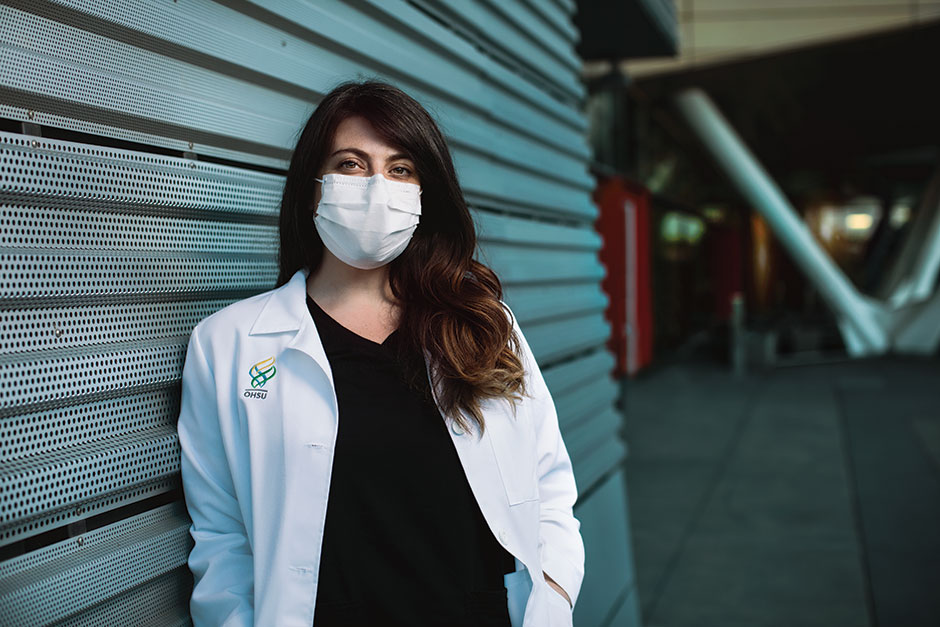
For the fall term, educators predict OHSU will have enough PPE — providing it stays managed conservatively — but students, faculty, staff and patients will need to be nimble to remain both safe and engaged in learning.
“Think of it like travel. You might not get a direct flight to where you need to go, or experience delays or unexpected connections. You’ll still get there,” Mejicano said.
What’s stayed constant
But the more things change, the more things stay the same: Namely, OHSU’s focus on high-caliber education, patient care and research. OHSU goes well beyond the basics in requirements, educators agree.
“For us, outside rule-makers aren’t enough. Our faculty decides what the standards are for a degree at our university. If national accreditors make changes, our faculty reviews them and decides if that’s sufficient,” Mejicano said.
Learn how OHSU students help meet the needs of disadvantaged communities.
“We wouldn’t graduate anyone without our faculty being confident they knew what they needed to know. No 2020 graduate finished who didn’t meet the same competency skills 2019 students did,” said David Robinson, PhD, executive vice provost at OHSU.
“Is it ideal? No,” he continued, “But it’s remarkable how we have kept the education mission going during a once-in-a-lifetime event. That’s a testament to staff and faculty during an extremely stressful time in all our lives.”
